Similar to how the offense lines up in different varieties of formations, defenses have formations as well. As the offense will line up in the “I-formation” or the “Wing-T,” defensive formations contain numbers that typically identify the defensive lineman and the linebackers.
Defensive formations are named after the number of defensive linemen and linebackers. For example, and 3-4 defense features 3 defensive linemen and 4 linebackers. Each defensive formation is run based on the offense’s personnel.
In this article, we will explain defensive formations and how they can be used to defeat the offense.
Football Defensive Formations
The number system is universally known to identify defenses. Here is the breakdown:
1st Number = Defensive Lineman
2nd Number = Linebackers
The number not shown or mentioned is the defensive backs. It’s assumed the defensive backs will complete the number of players on the field. For example:
A 4-3 defense will have 7 defensive linemen and linebackers on the field (4 defensive linemen + 3 linebackers). Because there are 11 players on the field at one time, it’s understood there must be 4 defensive backs on the field (7 defensive linemen/linebackers + 4 defensive backs).
If you want to learn more about defensive fronts in football, we recommend you check out this article.
Each front is designed with a defensive line designed to beat offensive linemen with speed and power. Defensive players must dedicate themselves to the scheme. Any player who takes plays off or isn’t disciplined to do what they’re taught to do, could result in big gains for the offense.
4-3 Defense
To start, let’s take a look at the 4-3 defense, one of the most basic defensive sets. The 4-3 defense includes:
- 4 Defensive Linemen
2 Interior Defensive Tackles
2 Exterior Defensive Ends - 3 Linebackers
1 Middle Linebacker
2 Outside Linebackers - 4 Defensive Backs
Two Safeties
Two Cornerbacks
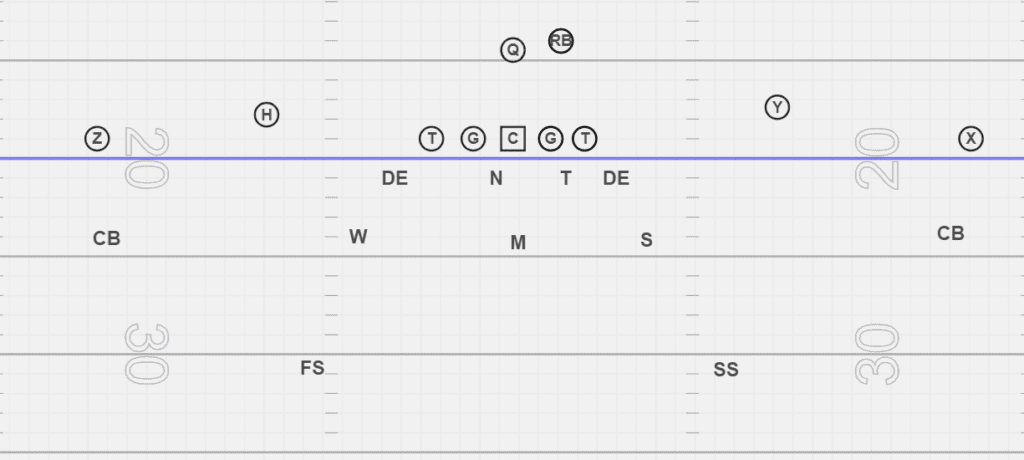
The 4-3 is also one of the more balanced defensive sets, as it allows teams to be aggressive to the run and have enough defenders to play the pass effectively.
The four defensive linemen provide a balanced pass rush and can stop the run. The defensive tackle on the center should be a bigger player that can clog the A gap and be the anchor point for the center of the defense.
The opposing offense should have trouble blocking 7 defenders who are committed to stopping the run, simply because they are outnumbered.
The free safety and the strong safety are the two deep safeties and then the two cornerbacks will play to the outside. Common coverages in the 4-3 defense are cover 2 and cover 4.
3-4 Defense
The 3-4 defense, similar to the 4-3 defense, has 7 players that play within the box.
- 3 Defensive Linemen
1 Nose Tackle
2 Defensive Ends - 4 Linebackers
2 Inside Linebackers
2 Outside Linebackers - 4 Defensive Backs
Two Safeties
Two Cornerbacks
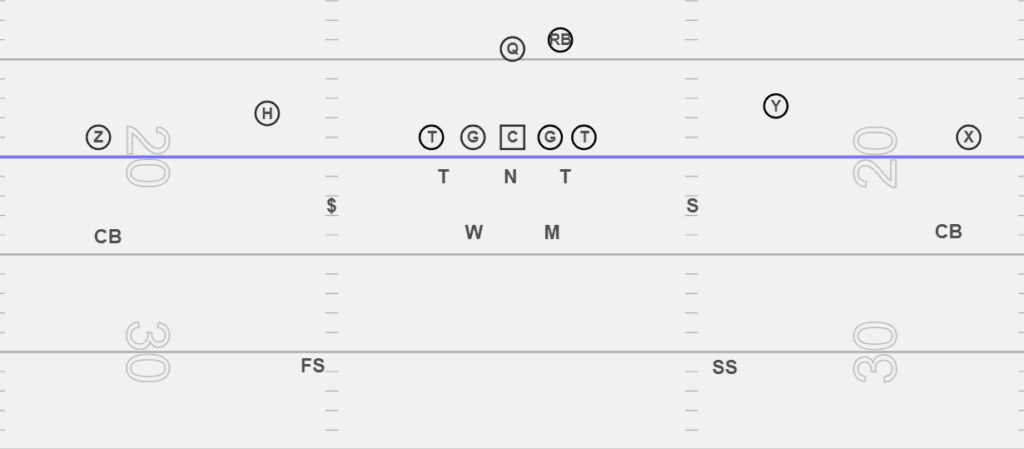
The 3-4 defense is unique because it has fewer guys at the point of attack on the line of scrimmage but is extremely effective for slanting and confusing defenses.
The three defensive linemen can be smaller players who can move quickly or bigger players who can anchor the line of scrimmage. It’s up to the defensive coordinator what kind of personnel he wants on the field.
The four linebackers can support the passing defense and still be available to stop the offense’s rushing attack. These four linebackers can also run zone blitzes to confuse the quarterback and the opposing offensive coordinator.
Similar to the 3-4, the defense can run pretty much any coverage out of the 3-4 defense, including cover 1 and cover 0. It is one of the most flexible defenses in football.
3-3 Stack
Like the 3-4 defense, the 3-3 stack has become a popular formation to counter against the spread passing attack. It lacks in lineman at the point of attack; it makes up in the passing game by adding an extra defender to the mix.
- 3 Defensive Linemen
1 Nose Tackle
2 Defensive Ends - 3 Linebackers
1 Middle Linebacker
2 Outside Linebackers - 5 Defensive Backs
1 Nickelback
2 Cornerbacks
2 Safeties
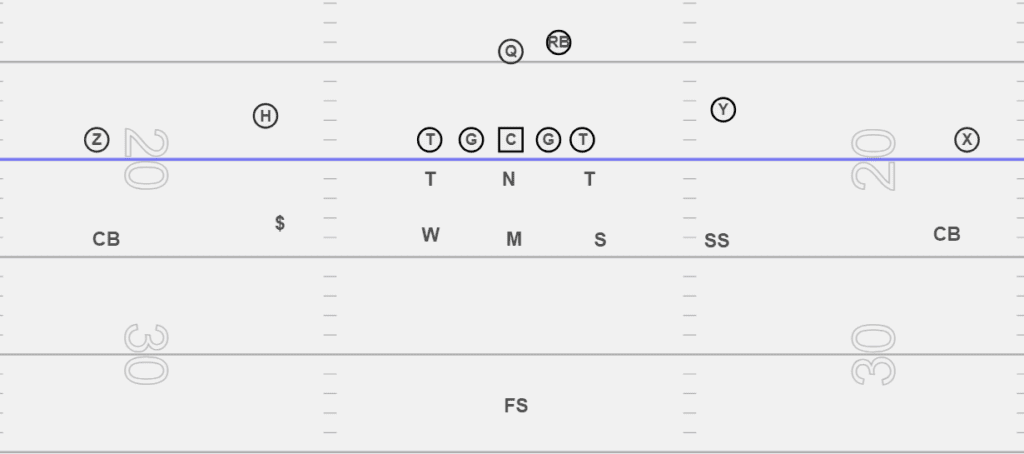
The 3-3 stack is relatively new as the spread offense has emerged. Teams can be aggressive from the defensive back and linebacker position, utilizing more speed on the field.
Teams who run the 3-3 stack will have three linemen and 3 linebackers.
Coverage wise, teams who run the 3-3 stack will have five defensive backs on the field to cover the pass. This is also known as a nickel defense (have 5 defensive backs on the field).
This helps them have more speed to cover the pass but also have enough players in the box to stop the run. The three linebackers all need to be athletic to cover the pass but also tough enough to stop the run.
Common coverages in the 3-3 stack are cover 1 and cover 3. Both of these coverages have a safety in the middle of the field for deep coverage. The 3 down linemen provide an initial pass rush and defensive coordinators will often have linebackers add to the blitz with this defensive formation.
4-2-5 Defense
Similar to the 3-3 stack, the 4-2-5 defense relies on the nickel formation, meaning they will use a Nickelback player to play nickel defense.
- 4 Defensive Linemen
2 Defensive Tackles
2 Defensive Ends - 2 Linebackers
2 Middle Linebacker - 5 Defensive Backs
1 Nickelback
2 Cornerbacks
2 Safeties
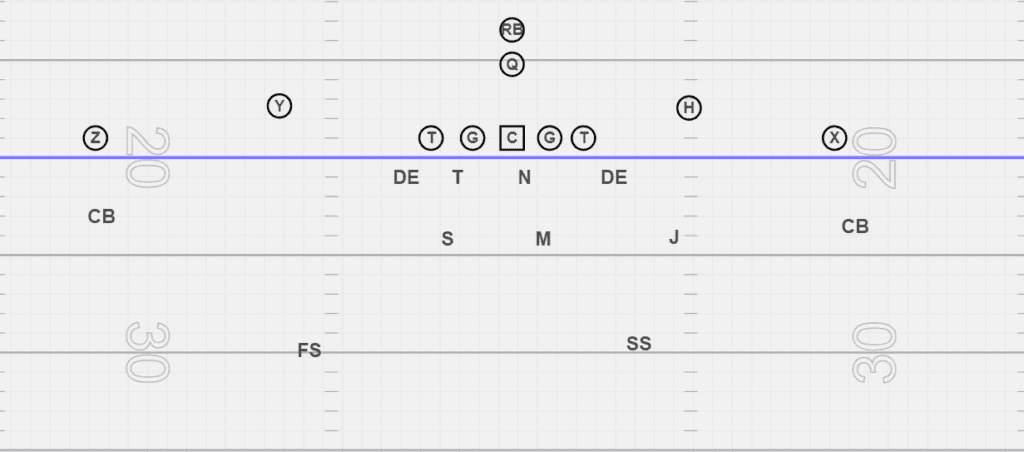
The 4-2-5 defense is great for teams who still want to rush 4 linemen toward the quarterback, and have enough people on the back end to cover.
The defensive ends are responsible for containing the offense’s run game. Meaning, if the offense runs to the outside, the defensive ends need to make sure they turn it back to the inside.
The strong safeties and free safeties will anchor the passing situations for this defense. Having the extra defensive back on the field allows for coverage responsibilities to fluctuate between the three safeties.
5-2 Defense
The 5-2 defense is the first defense on our list that tips the balance of run/pass support. 7 players remain in the frame of the defense. However, there are more players (5) on the line of scrimmage. Let’s break it down:
- 5 Defensive Lineman
1 Nose Guard
2 Defensive Tackles
2 Defensive Ends - 2 Linebackers
2 Inside Linebackers - 4 Defensive Backs
2 Safeties
2 Cornerbacks
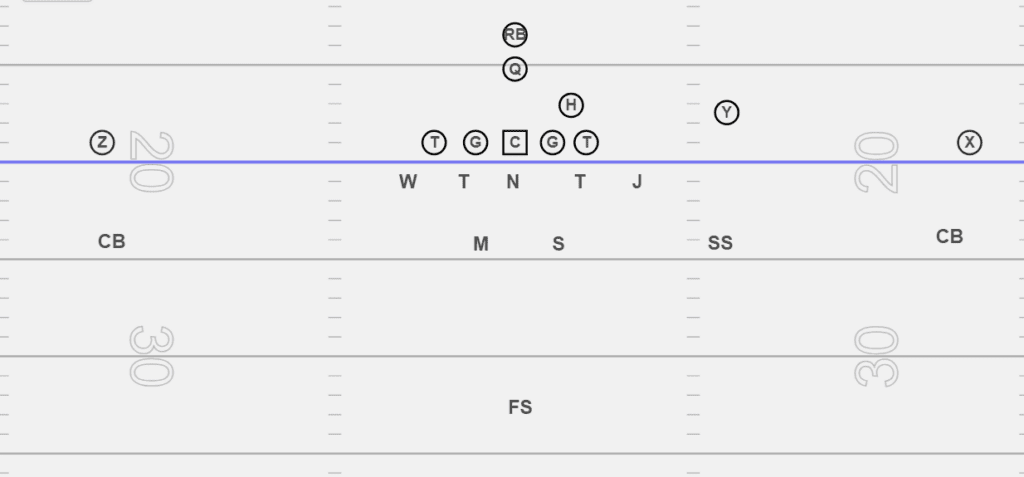
The 5-2 is a great run-stopping formation to enable linebackers to get free and make plays. It does, however, limit the pass defense to only 6 passing defenders.
The two linebackers need to be the two best tacklers on the team. Just based on the structure of the defense, the five defensive linemen need to hold their gaps while the linebackers scrape to make plays off tackle.
6-2 Defense
The 6-2 formation is often seen in goal-line sets, where the team is heavily anticipating the run. Let’s break down the 6-2 defense:
- 6 Defensive Lineman
2 Nose Tackles ( one on each side of the center)
2 Interior Defensive Linemen
2 Exterior Defensive Linemen - 2 Linebackers
2 Interior Linebackers - 3 Defensive Backs
1 Safety
2 Cornerbacks
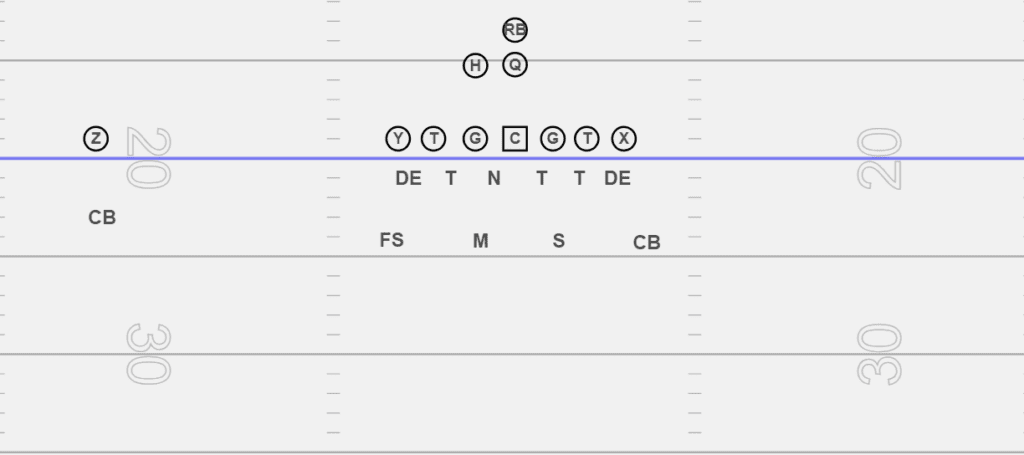
Teams will also have their defensive lineman line up in 4 point stances, getting as low as possible to create a pile.
The six defensive linemen help to create a wall against any team that wants to run the football. Offensive formations that defenses will often see against the 6-2 defense are double tight end formations and the t formation.
This football defensive formation is often seen on the goal line or short yardage situations.
Learn How To Watch Film Properly…
Uncover your opponent’s offensive and defensive tendencies so you can easily build a game plan.
Inside You’ll Find:
- Strategies to pick apart defenses
- How to identify player weaknesses
- How to save time in your weekly breakdowns
What Is The Best Defensive Formation?
There is no best defensive formation. Everything comes down to technique and matching personnel on the field.
For example, if the offense has a tight end and a full back on the field, it’s advantageous for the defense to have another linebacker on the field. This is so the defense can match the size that the offense presents.
On the other hand, if the offense has 4 receivers on the field, it will be in the defense’s favor to have more defensive backs on the field. This is to counteract the speed of the offense.
Each coach has their own philosophy on how defensive formation should be run. No one team is the same, as techniques, schemes, and even blitz patterns change from team to team.
The bottom line is that as long as gaps are covered in the run game, it will be hard for the offense to run the football.
If the defense can play an effective zone and man coverage, the defense will be effective in the passing game. No matter how many people are on the line of scrimmage, it comes down to playing both run and pass defense to be a dominant defense.
These formations are run in youth football, high school football, college football, and professional leagues.
The main goal is to keep the other team out of the end zone, so whatever best fits your team’s personnel, run it as your base defense.
What Defensive Scheme Should I Run?
There is no perfect scheme. Each coach has his own philosophy on which scheme works the best for the players that they have. Built into the scheme is a plethora of blitzes, coverages, and ways to counteract the offense’s game plan.
The personnel and scheme that you should run should fit the players you have on your roster.
For instance, if your team has 3 big, strong defensive linemen with a small linebacker core, it might be beneficial to run a 3-4. This way, the big lineman can fight against the offensive lineman while having more players drop back into pass coverage.
Each scheme should be predicated on the players and the coach’s comfort with teaching techniques/reads.
Keep Learning
If you liked learning about football defensive formations, we recommend you check out our Ultimate Football Guide. All of the content inside will help you drastically improve your football IQ.
If you’re looking for more scheme and technical based courses, our positions courses will be a great fit!
Defensive formations are named after the defensive lineman and linebackers that are on the field. These are the most common defensive formations:
- 3-4
- 3-3 Stack
- 4-2-5 Defense
- 4-3
- 4-4
- 5-2
- 6-2
Variations of these defenses have shown up on film and can be adjusted based on the offense’s formation.
When learning defensive formations, understand that the coaches can alter their scheme at any time and they often change based on the offense’s intent and the down and distance.
These are the most common defensive formations played from the youth, college, and professional levels. What are your favorite defensive formations? Let us know in the comment section below what’s been most effective for you.
Learn more about defense and how coaches use these formations to roll coverages, blitz the quarterback and disrupt blocking schemes at our blog!


